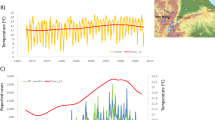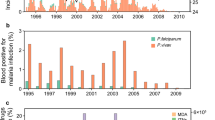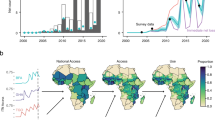Abstract
Arising from: R. W. Snow, C. A. Guerra, A. M. Noor, H. Y. Myint & S. I. Hay Nature 434, 214–217 (2005); see also communication from Nahlen; Snow et al. reply.
Accurate estimates of the global burden of malaria are important for planning, monitoring and advocacy. Snow et al.1 attempt to address the shortcomings of previous estimates of the incidence of malaria caused by Plasmodium falciparum by combining current and historical data. However, we believe that the design of their model and its inputs have led to a significant overestimate of the malaria burden outside Africa — as in the example of the World Health Organization (WHO) western Pacific region (WPR), for which their model predicts 60 times the 2002 incidence reported by national malaria-control programmes2.
This is a preview of subscription content, access via your institution
Access options
Subscribe to this journal
Receive 51 print issues and online access
$199.00 per year
only $3.90 per issue
Buy this article
- Purchase on Springer Link
- Instant access to full article PDF
Prices may be subject to local taxes which are calculated during checkout
Similar content being viewed by others
References
Snow, R. W., Guerra, C. A., Noor, A. M., Myint, H. Y. & Hay, S. I. Nature 434, 214–217 (2005).
World Health Organization Malaria, other vectorborne and parasitic diseases: Regional trend in cases and deaths, 2003. http://www.wpro.who.int/sites/mvp/data/ (2005).
Lysenko, A. J. & Semashko, I. N. in Medicinskaja Geografija: Itogi Nauki 1966 (ed. Lebedew, A. W.) 25–145 (VINITI, Moscow, 1968).
Gillies, M. T. in Malaria: Principles and Practice of Malariology (eds Wernsdorfer, W. H. & McGregor, I.) 453–485 (Churchill Livingstone, Edinburgh, 1988).
United Nations Environment Programme Asia-Pacific Environment Outlook 2: Regional Resource Centre for Asia and the Pacific (Pathumthani, Thailand, 2001). http://www.rrcap.unep.org/reports/apo2.cfm
Carter, R., Mendis, K. N. & Roberts, D. Bull. World Health Organ. 78, 1401–1411 (2000).
Torres, E. P., Salazar, N. P., Belizario, V. Y. & Saul, A. Acta Trop. 63, 209–220 (1997).
Anthony, T. G. et al. J. Infect. Dis. 191, 1558–1564 (2005).
Socheat, D. et al. Southeast Asian J. Trop. Med. Public Health 34 suppl 4, 1–102 (2003).
WHO Expert Committee on Malaria: 20th Report (World Health Organization, Geneva, 2000). http://www.rbm.who.int/docs/ecr20.pdf
Author information
Authors and Affiliations
Corresponding author
Rights and permissions
About this article
Cite this article
Bell, D., Jorgensen, P., Christophel, E. et al. Estimation of the malaria burden. Nature 437, E3–E4 (2005). https://doi.org/10.1038/nature04179
Published:
Issue Date:
DOI: https://doi.org/10.1038/nature04179
This article is cited by
-
Effect of Plasmodium falciparum malaria parasites on haematological parameters in Ghanaian children
Journal of Parasitic Diseases (2016)
-
Identification of circulating biomarkers in sera of Plasmodium knowlesi-infected malaria patients – comparison against Plasmodium vivax infection
BMC Infectious Diseases (2015)
-
Imported malaria in a cosmopolitan European city: A mirror image of the world epidemiological situation
Malaria Journal (2008)
-
Antiplasmodial Marine Natural Products in the Perspective of Current Chemotherapy and Prevention of Malaria. A Review
Marine Biotechnology (2006)
-
Estimating clinical episodes of malaria (reply)
Nature (2005)
Comments
By submitting a comment you agree to abide by our Terms and Community Guidelines. If you find something abusive or that does not comply with our terms or guidelines please flag it as inappropriate.



